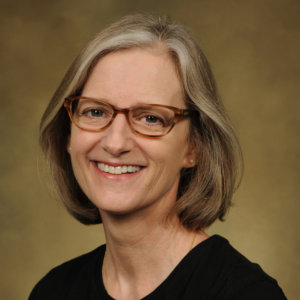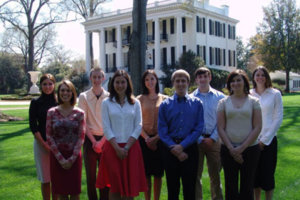Where It All Started: The Platform Magazine Story
Published on December 7, 2017, at 1:18 p.m.
by Hope Runyan.
A student-run, online publication focused on the creative exchange of ideas between practitioners, professionals and students, Platform Magazine is an all-encompassing public relations magazine. From the discussion of ethics to industry trends, Platform exists to encourage creativity and inspire those in the field of public relations.
From its start in 2007, Platform has had quite the journey. Ten years later, Platform has an international following, encouraging practitioners around the world to contribute to each publication. In total, more than 260 University of Alabama students have written for Platform over the years. So, how did Platform get its start?
The groundwork

Dr. Meg Lamme, now a full professor in the Department of Advertising and Public Relations at The University of Alabama, began her path in academia at Georgia State University.
She worked in the Atlanta area for over 15 years. Her career encompassed nonprofit, corporate and government public relations work. After a full career, Lamme decided that she needed a change. Her next step was to head into the world of academia, and she began teaching part time at Georgia State. Here, she discovered her new niche.
This discovery led Lamme to receive her Ph.D. from The University of Alabama and return three years later to join the UA faculty.
The push for Platform
In 2006, Dr. Bruce K. Berger, who was then the UA department chair of advertising and public relations and the director of the Plank Center for Leadership in Public Relations, invited Lamme to attend a board meeting for The Plank Center. At that meeting, the board discussed the idea of a student-run, online magazine, which at the time would be one of the first in the country. With the approval of the board members and Board Chairwoman Betsy Plank, the creation of Platform began.
This was no small task. In its first semester, students would have to lay the foundation for Platform — from target market research to creative design — and then present it to the Plank Center board. Dr. Lamme, as well as Susan Daria and Tracy Sims, UA advertising and public relations faculty members, needed to find the best and brightest students in the college to initiate Platform.
“I felt very strongly that if we were going to do this, it had to be student-driven,” said Lamme. “And to do that, we had to competitively select students.”
The selection process began. To make it a class compatible for seniors, Platform was offered as a campaigns course, which is a capstone class for students to apply the four-step communication plan process.
In addition to interviewing students for the Platform class, Lamme, Daria and Sims had to design the layout of the class. Each student in the class would be a writer and editor, and the class would be divided into three teams — design, communication and marketing. This class structure remains the same today.
The first class

After interviewing candidates, Lamme, Daria and Sims selected nine students to partake in Platform’s inaugural year. They knew what they were getting into, and they understood the work that needed to be done. With the selection of these nine students, Platform began.
The first class faced many obstacles; one of biggest was technological options. Versus the WordPress application that the class uses now, HTML coding was originally used for the first website. Each written piece had to be individually coded into the program, which resulted in large, clumped uploads of articles. Today, Platform can publish an article or blog to the website with a click of a button. The switch to WordPress came in 2011, and it has helped the class add links and photographs to each article before it’s scheduled for publication.
Lamme best describes her first students in one word — rockstars.
“They were just rockstars. We had to think about all the facets of Platform: what technology we would use, what our content would be and who would be our audience. And they made it happen,” Lamme explained.
As for the name, Lamme said that it had to represent students. “It needed to be in the students’ language. It needed to be their content and their perspective; it needed to be them talking to each other on a platform that was meaningful to them.”
The reflection: 10 years later
Today, Platform continues to grow. Students enter the class with a certain skill set and leave it with one that is more refined. They interview industry professionals, start a conversation and pitch blogs to professional outlets. Platform has become a showcase class in the College of Communication and Information Sciences at The University of Alabama, and students know that Platform will prepare them for what’s next.
“Platform is out there for the world,” said Dr. Joseph Phelps, current department chair of advertising and public relations. “It has become a networking tool for students to extend their reach into the professional realm.”
Dr. Meg Lamme instructed the first Platform class, and then Tracy Sims transitioned over — a transition, Lamme said, that has proved to be a great decision. With the direction of Sims, Platform has grown in depth, content and reach in ways that Lamme had hoped.
As for Lamme, Platform isn’t her only big initiative with the College of Communication and Information Sciences. She also played a key role in creating Capstone Agency, (link) The University of Alabama’s student-run, integrated communications firm.
“Platform helped to put us on the map,” said Lamme. “Now, it’s about the power of the content, the thought going into the work and the connections.”
Looking forward, she says that Platform will face the challenge of bringing in new technology — but it’s faced this issue before. Lamme hopes that Platform will become a portal to other media technologies and still remain relevant.
Dr. Lamme will leave The University of Alabama in the spring of 2018. After creating a legacy within the College of Communication and Information Sciences, her role will not be easily filled.
On her accomplishments throughout her career in public relations and at The University of Alabama, Lamme offers the following reflection:
“I came to the academy 19 years ago, building on over 15 years of experience in the public relations industry. Over that time, I published three books (two national award-winners and one in Spanish), one monograph, 19 journal articles, and 33 chapters, reviews, and essays; made 59 academic presentations in the U.S. and abroad; taught 17 courses; supervised 39 independent studies; advised two different PRSSA chapters; and served on 48 graduate student committees and over 123 academic and industry service boards, committees, and projects. My contributions were recognized by the academy and the industry more than 40 times. And I’ve been accredited in public relations (APR) since 2001. In the process, I worked with students who met or exceeded my expectations and, often, their own, and I worked with colleagues whose insights and perspectives enriched our work together and, often, my own.
“The A+PR Department continues to grow in enrollment and in reputation while technology continues to accelerate and enhance challenges and opportunities for that growth. The same could be said of Platform. And just as I tapped my industry and academic experiences to lead the launch of Platform, I continue to reap the benefits of the relationships we forged in that process.
“My reflection, then, comes down to the essence of public relations: relationships. It’s been said that it takes hard work to be lucky, and I’m fortunate to have had a rich and vibrant career marked by a broad range of friendships and collaborations. I will not look back on these, though, when I leave UA; instead, I will look forward to bringing them with me.”




